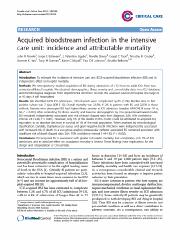Please use this identifier to cite or link to this item:
https://ahro.austin.org.au/austinjspui/handle/1/11227| Title: | Acquired bloodstream infection in the intensive care unit: incidence and attributable mortality. | Austin Authors: | Prowle, John R;Echeverri, Jorge E;Ligabo, E Valentina;Sherry, Norelle;Taori, Gopal C;Crozier, Timothy M;Hart, Graeme K ;Korman, Tony M;Mayall, Barrie C;Johnson, Paul D R ;Bellomo, Rinaldo | Affiliation: | Intensive Care | Issue Date: | 21-Mar-2011 | Publication information: | Critical Care 2011; 15(2): R100 | Abstract: | To estimate the incidence of intensive care unit (ICU)-acquired bloodstream infection (BSI) and its independent effect on hospital mortality.We retrospectively studied acquisition of BSI during admissions of >72 hours to adult ICUs from two university-affiliated hospitals. We obtained demographics, illness severity and co-morbidity data from ICU databases and microbiological diagnoses from departmental electronic records. We assessed survival at hospital discharge or at 90 days if still hospitalized.We identified 6339 ICU admissions, 330 of which were complicated by BSI (5.2%). Median time to first positive culture was 7 days (IQR 5-12). Overall mortality was 23.5%, 41.2% in patients with BSI and 22.5% in those without. Patients who developed BSI had higher illness severity at ICU admission (median APACHE III score: 79 vs. 68, P < 0.001). After controlling for illness severity and baseline demographics by Cox proportional-hazard model, BSI remained independently associated with risk of death (hazard ratio from diagnosis 2.89; 95% confidence interval 2.41-3.46; P < 0.001). However, only 5% of the deaths in this model could be attributed to acquired-BSI, equivalent to an absolute decrease in survival of 1% of the total population. When analyzed by microbiological classification, Candida, Staphylococcus aureus and gram-negative bacilli infections were independently associated with increased risk of death. In a sub-group analysis intravascular catheter associated BSI remained associated with significant risk of death (hazard ratio 2.64; 95% confidence interval 1.44-4.83; P = 0.002).ICU-acquired BSI is associated with greater in-hospital mortality, but complicates only 5% of ICU admissions and its absolute effect on population mortality is limited. These findings have implications for the design and interpretation of clinical trials. | URI: | https://ahro.austin.org.au/austinjspui/handle/1/11227 | DOI: | 10.1186/cc10114 | ORCID: | Journal: | Critical Care | URL: | https://pubmed.ncbi.nlm.nih.gov/21418635 | Type: | Journal Article | Subjects: | Aged Australia.epidemiology Bacteremia.epidemiology.mortality Cross Infection.epidemiology.mortality Databases, Factual Female Hospital Mortality Hospitals, University Humans Incidence Intensive Care Units.statistics & numerical data Male Middle Aged Retrospective Studies Risk Assessment |
| Appears in Collections: | Journal articles |
Files in This Item:
| File | Description | Size | Format | |
|---|---|---|---|---|
| 21418635.pdf | 828.88 kB | Adobe PDF |  View/Open |
Page view(s)
54
checked on Feb 20, 2025
Download(s)
118
checked on Feb 20, 2025
Google ScholarTM
Check
Items in AHRO are protected by copyright, with all rights reserved, unless otherwise indicated.
